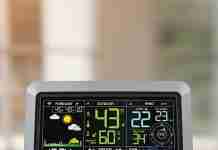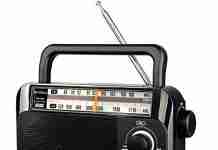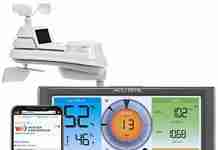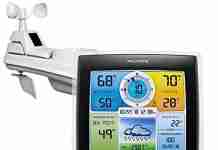Curious about the disparity between a personal weather station and a professional-grade one? Look no further! In this article, we’ll explore the key distinctions between these two types of weather stations. Whether you’re a weather enthusiast or simply want accurate forecasts for your home or business, understanding the variations in features and capabilities will help you make an informed decision. So, let’s dive in and discover the dissimilarities that set these weather stations apart.
Review contents
What Is The Difference Between A Personal Weather Station And A Professional Grade Weather Station?
Key Differences Between Personal Weather Station and Professional Grade Weather Station
When it comes to monitoring the weather, there are two primary types of weather stations: personal weather stations and professional grade weather stations. Both serve the purpose of gathering weather data, but they vary in terms of accuracy, data collection and reporting capabilities, instrumentation, customization options, data access and connectivity, cost, maintenance and support, and intended use and user.
Accuracy and Reliability
One of the most significant differences between a personal weather station and a professional grade weather station lies in their accuracy and reliability. Professional grade weather stations are designed to meet strict accuracy standards and are often calibrated to ensure precise measurements. On the other hand, personal weather stations may not undergo the same level of calibration and may have a higher margin of error. This difference in accuracy and reliability is essential for users who require highly accurate and dependable weather data.
Data Collection and Reporting
Professional grade weather stations are equipped with advanced sensors and instruments that enable them to collect a wide range of weather data. These stations often measure temperature, humidity, wind speed and direction, atmospheric pressure, precipitation, solar radiation, and UV index, among other variables. In contrast, personal weather stations typically have a more limited set of sensors and may only collect basic weather data such as temperature and humidity. Additionally, professional grade weather stations often offer more detailed reports and analysis options, whereas personal weather stations may provide basic data summaries.
Instrumentation
In terms of instrumentation, professional grade weather stations tend to have more sophisticated and accurate sensors. These sensors are usually of higher quality and are calibrated to deliver precise measurements. Personal weather stations, on the other hand, often feature sensors that are geared towards general weather monitoring rather than scientific accuracy. While personal weather stations may be suitable for many hobbyists and weather enthusiasts, they may not meet the standards required for scientific research or specialized applications.
Customization and Expandability
Professional grade weather stations offer a higher level of customization and expandability compared to personal weather stations. Users of professional grade stations often have the ability to select specific sensors and instruments based on their needs and can expand their station’s capabilities as desired. These stations often offer a range of additional sensors, accessories, and software options that allow for more comprehensive weather monitoring. Personal weather stations, on the other hand, are typically less customizable and may have limited options for adding or upgrading sensors, limiting their overall functionality.
Data Access and Connectivity
In terms of data access and connectivity, professional grade weather stations often provide more options for accessing and sharing weather data. These stations are often equipped with data logging capabilities and can store large amounts of data internally. They may also offer various connectivity options such as Ethernet, Wi-Fi, or cellular data, allowing for remote access to real-time and historical weather data. Personal weather stations may require manual data collection or rely on limited connectivity options such as Bluetooth or wireless transmission to a nearby device, which can limit access to data and its subsequent analysis.
Cost
As expected, professional grade weather stations tend to be significantly more expensive than personal weather stations. These stations are built with higher quality materials, utilize more advanced technology, and undergo rigorous testing and calibration, all of which contribute to their higher cost. Personal weather stations, while still providing valuable weather data, are generally more affordable and accessible for the average consumer. The cost difference between the two types of stations can be a deciding factor for individuals or organizations with specific needs and budget constraints.
Maintenance and Support
Professional grade weather stations often come with more extensive maintenance and support options compared to personal weather stations. Manufacturers of professional grade stations typically provide regular firmware updates, technical support, and guidance for maintenance and calibration. Additionally, there may be service plans or extended warranties available to ensure the long-term functionality and accuracy of the station. In contrast, personal weather stations may have more limited maintenance and support options, making it important for users to be proactive in ensuring accurate and reliable data collection.
Intended Use and User
The intended use and the user’s level of expertise is another significant factor to consider when choosing between a personal weather station and a professional grade weather station. Personal weather stations are designed with the average user in mind, such as weather enthusiasts, homeowners, and hobbyists, who have a general interest in monitoring the weather conditions for personal use. Professional grade weather stations, on the other hand, cater to users who require highly accurate and reliable weather data for specialized purposes such as research, farming, aviation, or environmental monitoring. The intended use and user’s specific needs should guide the decision in selecting the appropriate weather station.
Conclusion
In conclusion, personal weather stations and professional grade weather stations differ in several key aspects such as accuracy, data collection and reporting capabilities, instrumentation, customization options, data access and connectivity, cost, maintenance and support, and intended use and user. By understanding these differences, individuals can make informed decisions based on their specific requirements and budget. Whether you are a weather enthusiast or a professional meteorologist, choosing the right weather station is crucial in obtaining accurate and reliable weather data to meet your needs.



































